 W
WThe Black Week was a crisis in Honolulu, Hawaii that nearly caused a war between the Provisional Government there and United States.
 W
WThe Congo–Arab War took place in what is now the Democratic Republic of the Congo between the forces of Belgian King Leopold II's Congo Free State and various Zanzibari Arab slave traders led by Sefu bin Hamid, the son of Tippu Tip. Fighting occurred in the eastern Congo between 1892 and 1894. It was a proxy war, with most of the fighting being done by native Congolese, who aligned themselves with either side and sometimes switched sides. The causes of the war were largely economic based, since Leopold and the Arabs were contending to gain control of the wealth of the Congo. The war ended in January 1894 with a victory of Leopold's Force Publique. Initially, King Leopold II collaborated with the Arabs, but competition struck over the control of ivory and the topic of Leopold II's humanitarian pledges to the Berlin Conference to end slavery. Leopold II's stance turned confrontational against his once-allies. The war against the Swahili-Arab economic and political power was presented as a Christian anti-slavery crusade.
 W
WThe Dutch intervention in Lombok and Karangasem took place in 1894, and is part of the string of Dutch interventions in and around Bali, Dutch East Indies, that led to complete colonization of both Bali and Lombok by the early 20th century.
 W
WThe Enid–Pond Creek Railroad War occurred in Oklahoma Territory between 1893 and 1894, and pitted the citizens of two United States designated county seats against the Rock Island Railroad.
 W
WThe Federalist Riograndense Revolution (1893–1895) was a civil war which occurred in southern Brazil against the recently-formed Republic. Urged by the political crisis generated by the federalists, an opposition group that sought to liberate Rio Grande do Sul from the governance of Julio de Castilhos, then president of the state, and also gain greater autonomy and decentralize the power of the then newly proclaimed Republic.
 W
WThe First Matabele War was fought between 1893 and 1894 in modern day Zimbabwe. It pitted the British South Africa Company against the Ndebele (Matabele) Kingdom. Lobengula, king of the Ndebele, had tried to avoid outright war with the company's pioneers because he and his advisors were mindful of the destructive power of European-produced weapons on traditional Matabele impis attacking in massed ranks. Lobengula reportedly could muster 80,000 spearmen and 20,000 riflemen, armed with Martini-Henry rifles, which were modern arms at that time. However, poor training meant that these were not used effectively.
 W
WThe First Melillan campaign, also called the Melilla War or the Margallo War in Spain, was a conflict between Spain and 39 of the Rif tribes of northern Morocco, and later the Sultan of Morocco, that began in October 1893, was openly declared November 9, 1893, and was resolved by the Treaty of Fez in 1894.
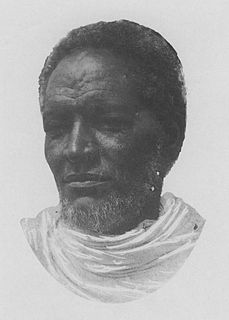 W
WThe Battle of Halai, or the Battle of Halay, which took place in December 1894, was one of the opening battles of the Eritrean Italian war.
 W
WThe Hamidian massacres, also referred to as the Armenian Massacres of 1894–1896 and Armenian genocide, were massacres of Armenians in the Ottoman Empire that took place in the mid-1890s. It was estimated casualties ranged from 80,000 to 300,000, resulting in 50,000 orphaned children. The massacres are named after Sultan Abdul Hamid II, who, in his efforts to maintain the imperial domain of the collapsing Ottoman Empire, reasserted Pan-Islamism as a state ideology. Although the massacres were aimed mainly at the Armenians, they turned into indiscriminate anti-Christian pogroms in some cases, such as the Diyarbekir massacre, where, at least according to one contemporary source, up to 25,000 Assyrians were also killed.
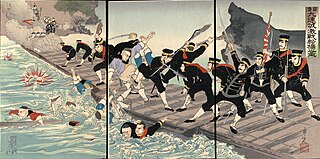 W
WThe Battle of Jiuliancheng (九連城之戰) was a land battle of the First Sino-Japanese War between the forces of Meiji Japan and Qing China. It is sometimes referred to as the Battle of the Yalu River , thus creating confusion with the previous naval conflict of the same name of 17 September, and the subsequent naval and ground battles of the Russo-Japanese War, with the same name and occurring at much the same location.
 W
WThe Battle of Kassala was fought on July 17, 1894, between an Italian colonial troop and Mahdist Sudanese forces.
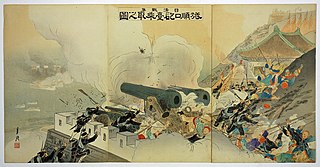 W
WThe Battle of Lüshunkou was a land battle of the First Sino-Japanese War. It took place on 21 November 1894 in Lüshunkou, Manchuria between the forces of the Empire of Japan and the Qing dynasty. It is sometimes referred to archaically in western sources as the Battle of Port Arthur.
 W
WThe Malaboch War (1894) was between Chief Malaboch of the Bahananwa (Xananwa) people and the South African Republic (ZAR) Government led by Commandant-General Piet Joubert. Malboch refused to pay taxes to the Transvaal after it was given back to the Boers in 1881 by the British, which resulted in a military drive against him by the South African Republic (ZAR).
 W
WThe Mat Salleh Rebellion was a series of major armed disturbances against the colonial British North Borneo Chartered Company administration in North Borneo, now the Malaysian state of Sabah. It was instigated by Datu Muhammad Salleh, a local chief from the Lingkabo district and Sugut River. He led the rebellion between 1894 until his death in Tambunan in 1900. The resistance then continued on for another 5 years until 1905.
 W
WThe Peruvian Civil War of 1894–1895 was an internal Peruvian conflict sparked by the election of Andrés Avelino Cáceres to the presidency of Peru. As Nicolás de Piérola and his forces entered the Peruvian capital, Lima, 1,000 people were killed. Cáceres resigned and Piérola became President of Peru.
 W
WThe Port Arthur massacre took place during the First Sino-Japanese War from 21 November 1894 for two or three days, when advance elements of the First Division of the Japanese Second Army under the command of General Yamaji Motoharu (1841–1897) killed somewhere between 1,000 and 20,000 Chinese servicemen and civilians in the Chinese coastal city of Port Arthur. The battle is notable for its divergent coverage by foreign journalists and soldiers, with contemporaneous reports both supporting and denying narratives of a massacre by the Japanese military.
 W
WThe Battle of Pungdo or Feng-tao was the first naval battle of the First Sino-Japanese War. It took place on 25 July 1894 off Asan, Chungcheongnam-do, Korea, between cruisers of the Imperial Japanese Navy and components of the Chinese Beiyang Fleet. Both China and Japan had been intervening in Korea against the Donghak Peasant Revolution. While China tried to maintain her suzerain relationship with Korea, Japan wanted to increase her sphere of influence.
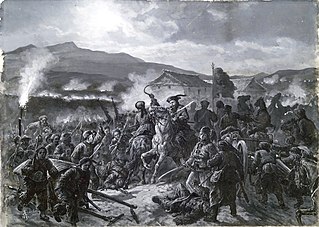 W
WThe Battle of Pyongyang was the second major land battle of the First Sino-Japanese War. It took place on 15 September 1894 in Pyongyang, Korea between the forces of Meiji Japan and Qing China. It is sometimes referred to archaically in Western sources as the "Battle of Ping-yang". Between 13,000 and 15,000 Chinese troops of the Beiyang Army under overall command of General Ye Zhichao had arrived in Pyongyang on 4 August 1894, and had made extensive repairs to its ancient city walls, feeling itself secure in its superior numbers and in the strength of the defenses.
 W
WThe Revolution of the 44 or Revolución de los 44 refers to a group of Salvadoran rebel Generals, known as the 44 who rebelled against the government of general Carlos Ezeta in 1894 in El Salvador. They took the city of Santa Ana and forced the authorities and the President out.
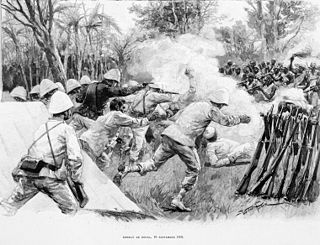 W
WThe Second Franco-Dahomean War, which raged from 1892 to 1894, was a major conflict between the French Third Republic, led by General Alfred-Amédée Dodds, and the Kingdom of Dahomey under King Béhanzin. The French emerged triumphant and incorporated Dahomey into their growing colonial territory of French West Africa.
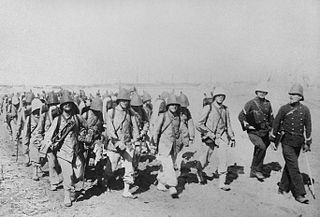 W
WThe Second Madagascar expedition was a French military intervention which took place in 1894–95, sealing the conquest of the Merina Kingdom on the island of Madagascar by France. It was the last phase of the Franco-Hova War and followed the First Madagascar expedition of 1883–85.
 W
WThe Battle of Seonghwan was the first major land battle of the First Sino-Japanese War. It took place on 29 July 1894 at the hamlet of Seonghwan, outside of Cheonan, Chungcheongnam-do Korea between the forces of Meiji Japan and Qing China. It is also referred to as the Battle of Asan.
 W
WThe Battle of the Yalu River (simplified Chinese: 黄海海战; traditional Chinese: 黃海海戰; pinyin: Huáng Hǎi Hǎizhàn; Japanese: Kōkai-kaisen was the largest naval engagement of the First Sino-Japanese War, and took place on 17 September 1894, the day after the Japanese victory at the land Battle of Pyongyang. It involved ships from the Imperial Japanese Navy and the Chinese Beiyang Fleet.